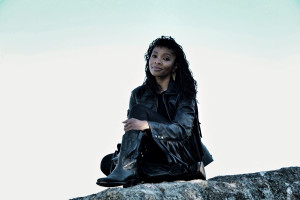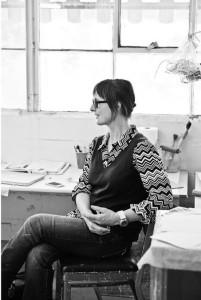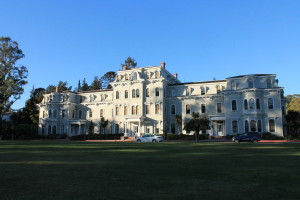

Indira Allegra and Rebeca Bollinger are this semester’s artists-in-residence for A+P+I, or the Art, Process and Ideas collaboration between the Mills College Art
Museum and the Art Department. They presented past works and their perspectives on creation in the “Artists In Conversation” event Friday, Feb. 23 in Danforth
Lecture Hall.
“We pick artists who are going to have the most interaction community-wide here at Mills,” Museum Director Dr. Stephanie Hanor said. “I like to think of the residency as a laboratory time
for the artist.”
‘Cloth can hold
emotion that’s too big for our bodies to hold, grief that’s too
big to hold.’
— Indira Allegra
A+P+I started in 2015 and gives artists get full use of a private
studio, access to Mills art facilities and faculty, a summer exhibition of their work and each is paid an honorarium for their time here.
Allegra weaves portraits
and objects, as well as multimedia and performances, sharing themes of weaving and textiles
holding memory.
“I always think of cloth as being the original external hard drive,” Allegra said. “Cloth can hold
emotion that’s too big for our bodies to hold, grief that’s too
big to hold.”
Allegra shared photos and videos of her shows, performances and process, like weaving newsprint-yarn on street corners to honor victims of hate crimes in the locations they suffered. Another installation was a room full of small, repeating video clips interwoven like digital textiles of news footage about killings by police. The black and white grid pattern was based on
the cloth that makes police
uniforms, structured to easily wash out blood stains.
“A lot of my work deals with social violence and interpersonal violence,” Allegra said. “I work with tension as a creative material. I think about the tension with intimacy and violence and tension within the body.”
Bollinger is working on her “Catalog of Stains.” Part of it is a series of 3D mixed-media sculptures — the stains — made by layering ceramic, molten aluminum, glass and bronze.
She subtly explained “stains” by reading a list of their titles.
One was called “Dick in a McDonalds bag.”
“That’s a true story,” she said.
She also makes other ordinary objects into sculptures, like “porcelain tube socks, because tube socks are one of my stories,” Bollinger said. “I think about making maps, making stories, making writings that become visual art generators.”
After making visual pieces, her process lately loops back to writing. She catalogues her art pieces, memories and impressions into maps of thoughts on paper, three-ring binders, photos and creative writing.
“I’m kind of nervous because you’re the first group that I’ve read to outside of my writing workshop. But I’m just going for it because everything is about shame and risk,” Bollinger said.
She read an excerpt of her writing about impressions of one of her childhood homes which sat next to a freeway. It had dark rooms with tilting walls and she sensed an indoor fog that drifted throughout the house.
Both artists are just beginning to explore the campus, and answered questions about what they plan
to do here.
“I’m so obsessed with tension. I’m excited to stumble into some haunted corners of the campus,” Allegra said.
Haunting is a theme she’s been working with, and described it as the feeling, “It doesn’t feel good here but everyone else seems fine.”
For Bollinger, a similar idea seemed to resonate.
“I’m haunted by Julia Morgan. I’m completely obsessed with her right now, and the bell tower. I’m not sure what my show will be,” Bollinger said. “There’s something about this campus that really allows time to think.”
Allegra and Bollinger will present their works in an exhibition curated by the Mills College Art Museum this summer.
The parameters are wide open, whatever the result. They are free to use this time
to experiment.
“We’ll work with whatever the artist is interested in presenting,” Dr. Hanor said.


